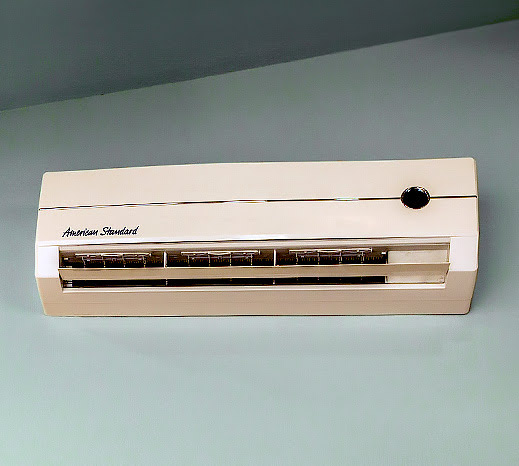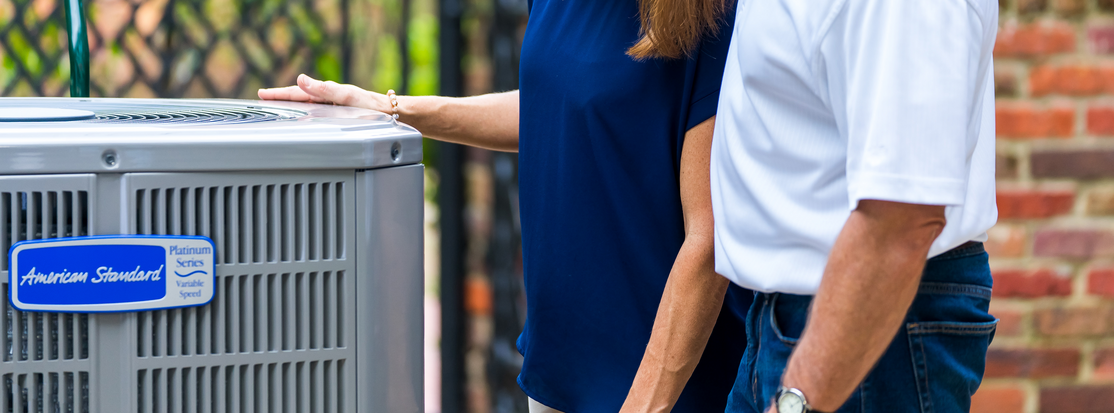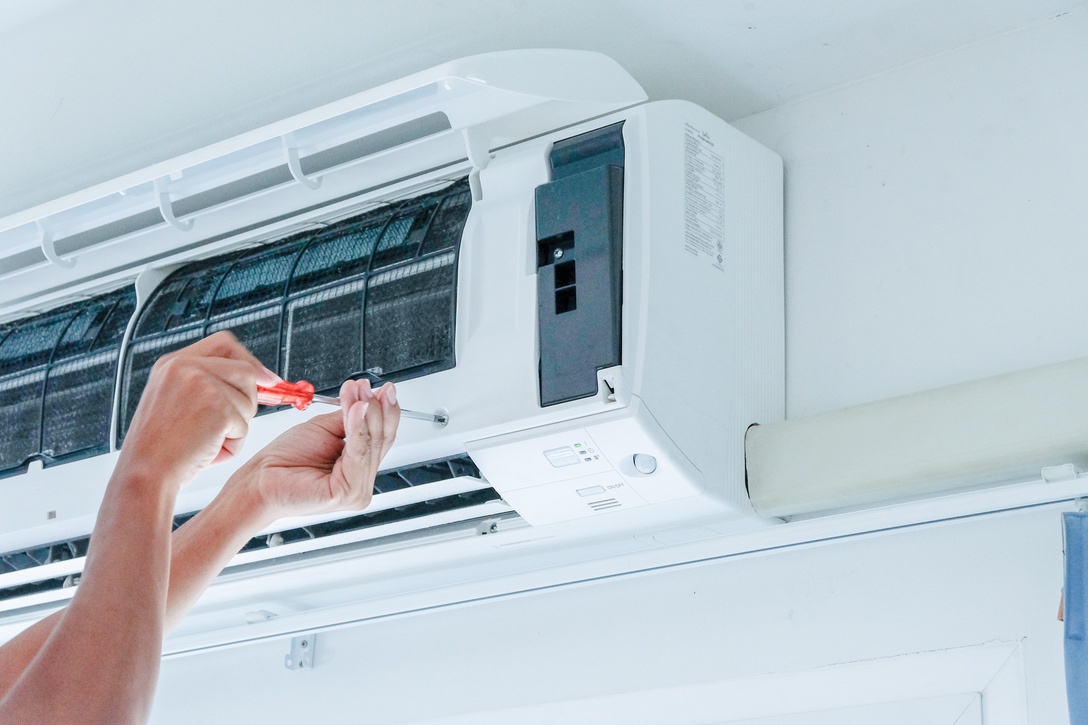Ultimately, choosing central air vs. ductless mini splits for your home in Lee’s Summit or Blue Springs comes down to your available space, ductwork, budget, and capacity to perform or pay for maintenance. Use this information to get a better idea of your needs—then contact our team for a professional recommendation on a system that will cool your home efficiently.

Cooling your home in Missouri’s hot summers is a must—but it’s important to think about the best way to do it before you invest in a new air conditioner. Central AC and ductless mini split systems are both great options, but you might find one type more practical than the other depending on your home and specific cooling needs.
Fortunately, our team has years of experience installing air conditioners in Lee’s Summit and Blue Springs, so we know all about the best kinds of systems for homes like yours. Read on for a point-by-point comparison between central air conditioners and ductless mini splits so you can confidently choose the right type for your home.

Energy Efficiency
Central air conditioning systems and ductless mini-splits both have their strengths when it comes to energy efficiency, but the ways in which they can save energy differ.
Central AC
Central air conditioners typically have a Seasonal Energy Efficiency Ratio (SEER) rating between 13 and 21. However, they often experience energy loss due to heat exchange in ductwork. It’s estimated that duct loss can account for up to 30% of energy consumption, especially if the ducts are in an unconditioned space like an attic. Regular AC tune-ups can help prevent leaks in your ductwork and reduce or eliminate energy lost this way.
Pros: Higher SEER models are highly efficient and suitable for cooling entire homes
Cons: Ductwork can lead to significant energy loss without routine maintenance
Ductless Mini-Splits
Ductless mini-split systems boast SEER ratings of up to 33, making them highly energy-efficient. They eliminate duct loss, and the zoned cooling feature allows homeowners to cool only occupied rooms, reducing unnecessary energy use. However, it’s important to note that it usually requires several of these units to cool an entire home at once, and the costs of running them at the same time can make this more expensive than central AC in the long run.
Pros: Exceptionally high SEER ratings, no duct loss, room-by-room control
Cons: Can be less efficient if many units are running simultaneously

Installation & Cost
The installation process and costs of central air systems and ductless mini-splits vary significantly.
Central AC
Installing central air can be quite involved, especially if ductwork isn’t already in place. The cost will depend on the size of your home, the specific unit you choose, and the complexity of installation. However, despite the higher upfront costs, central AC systems typically have lower costs per square foot to cool, especially in larger homes.
Pros: Lower cost per square foot for cooling
Cons: Higher upfront cost, especially if ductwork needs to be installed
Ductless Mini-Splits
Ductless mini-splits have a simpler installation process with less invasive construction, but each unit can be costly. This makes them a more cost-effective solution for smaller homes, room additions, or homes without existing ductwork.
Pros: Simpler, less invasive installation, effective for smaller spaces or homes without ductwork
Cons: Higher cost per unit, potentially higher overall costs for larger homes

Home Layout & Adaptability
Your home’s layout and existing infrastructure can greatly influence your choice between central air and ductless mini-split systems.
Central AC
Central air systems are best suited for houses with existing ductwork. They’re ideal for larger homes where the aim is to maintain a consistent temperature throughout. You can also make it possible to cool individual rooms or areas in your home by partitioning your ductwork and adding zone control (ask us how to do this; we can help!).
Pros: Great for larger homes, works best with existing ductwork
Cons: Not ideal for houses without ductwork, less flexibility in temperature control unless ducts are partitioned
Ductless Mini-Splits
Ductless mini-splits can be installed in homes without ductwork, in new additions, or in individual rooms. This makes them a good option for older homes, smaller spaces, or houses with complex architectural features—just remember, you’ll have to buy an individual unit for each area you want to cool.
Pros: High adaptability, no need for ductwork, good for homes with complex layouts
Cons: Usually require multiple units for larger homes

Aesthetics & Flexibility
When it comes to aesthetics and flexibility, central air systems and ductless mini-splits have unique attributes.
Central AC
Central air conditioners are unobtrusive, as the bulk of the system is hidden outdoors and in the basement or attic. They provide a uniform look and feel throughout the house, although upgrades and multiple thermostats are needed to provide individual room control.
Pros: Unobtrusive, consistent look and feel
Cons: Upgrades required for individual room control
Ductless Mini-Splits
Because they are separate units, ductless mini-splits let you customize the temperature for each room in which they are installed. However, it’s worth noting that the indoor units are highly visible and may not blend seamlessly with all décor.
Pros: Zoning capability, individual room control for every area where a unit is installed
Cons: Visible indoor units

Maintenance & Longevity
The maintenance requirements and expected lifespans of central air conditioners and ductless mini-splits also differ.
Central AC
Central systems typically require professional AC maintenance once a year, including changing the filter and checking the system. Properly maintained, they can last 15-20 years.
Pros: Longer lifespan when well-maintained
Cons: Requires annual professional maintenance
Ductless Mini-Splits
Ductless mini-splits require more frequent filter cleaning (typically every month), but this can often be done by the homeowner. They have a slightly shorter lifespan, typically around 12-15 years, but this can be extended with good maintenance.
Pros: Homeowners can perform some maintenance, no need for duct cleaning
Cons: Shorter lifespan, more frequent maintenance needed
Get the Right Kind of Cooling System for Your Home
Ultimately, choosing central air vs. ductless mini splits for your home in Lee’s Summit or Blue Springs comes down to your available space, ductwork, budget, and capacity to perform or pay for maintenance. Use the information above to get a better idea of your needs—then contact our team for a professional recommendation on a system that will cool your home efficiently.



